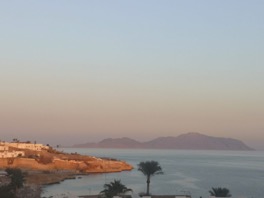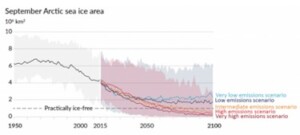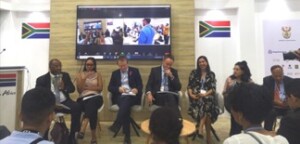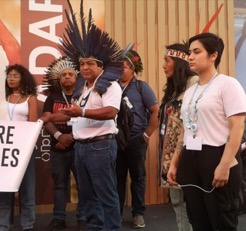Sinai has been the place of revelations in the Abrahamic traditions of Judaism, Christianity and Islam, divine messages coming to the prophets Elijah, Moses and Muhammed. It is an austere landscape of sharp, red, ragged peaks rising suddenly from the desert, fringing the azure blue corralled waters of the Red Sea. I ponder this history and the teachings of the prophets as I sit on the camel-coloured sand of Sharm El Shaikh at the very south of the peninsula. Along with 35 000 other people from 200 countries, I am here listening out for a revelation at COP27 and to join the frothy debates about our climate emergency. For a world in crisis, we seem not to be listening very well, or maybe we are unsure how God speaks to lowly mortals these days. Can we discern the spin of false prophets from the voices who offer hard truths about the ravages of climate change? Is there really an “us and them” and what will it take to be on the same side?

Source: author’s own photograph
My questions will surely not be answered by the official communications company hired to help organise and lead on messaging out of COP27. The US-based global public relations firm, Hill+Knowlton are known to be spin doctors for big oil like ExxonMobil, Shell, Chevron, Aramco, BP and other industry giants. They’re accused of blatant greenwashing and disinformation, misleading the public and blocking real climate action to reign in fossil fuels. It’s been reported that more than 600 delegates are from the fossil fuel industry, converging on Egypt to shape the debate. That’s 100 more lobbyists than last year, and more than any single country delegation besides the United Arab Emirates which has 1070 people registered for the talks. Hill+Knowlton has a long history of falsity, their work in the 50s and 60s refuting science-backed findings that smoking causes lung cancer.
So before the Conference of Parties even starts, Egypt’s big event is mired in contradiction, a tension I feel myself for the 6 flights I have taken here and back, the exorbitant hotel costs, the flashy pavilions, and the tons of waste this gathering for climate action will produce. I even imagine the mountain of towels 35 000 people will use over two weeks – enough for a modest mound on the Sinai perhaps? Knowing the impacts of hosting a global event as South Africa did in 2010 when we hosted the World Cup, I wonder how much of the local budget was siphoned to provide the infrastructure and finishings to buildings, palm-lined roads, and other conference logistics? So here I am, deeply complicit in all of this and still determined to glean some insight, inspiration and courage for my own orientation and research.
The science is clear – without rapid and sharp reductions in greenhouse gas emissions we will hurtle past the threshold 1.5 degrees global warming and headlong into climate breakdown. I made a point to check in daily with people in the know and stopped by the cryosphere’s glaring white pavilion with the most reading exhibits (I’m sure) at COP27. If anyone could calculate rising sea levels, timelines, melt rates and map vulnerable areas – it was folks who study ice. Their research in this year’s State of the Cryosphere Report paints a grim picture, even with low emissions. They project that loss of Arctic summer sea ice is inevitable or “terminal” and will disappear entirely before 2050 if we don’t change course fast.

Source: State of the Cryosphere, 2022 Report
This year’s report titled “Growing Losses, Global Impacts” holds a litany of frightening revelations – a September spike in Greenland surface melt; a 5% loss of glacial ice in the Alps this summer and the first recorded methane release from permafrost sites due to global warming. Are fossil fuel industries digesting this research? Are they dismissing these scientists as prophets of doom? What do financier’s risk-return profiles look like in a world of retreating glaciers, submerged coastal zones, stricken coral reefs, shrinking tropical forests and agricultural land? Who is their customer in this scenario?
I listen to a panel of all-white European investors, bar a woman asset manager from India. They admit the private sector is moving too slowly to be a catalyst for transition. They bemoan their own litany of constraints, citing a lack of bankable projects, currency risk, liquidity, scalability, lack of trust and of course the chimerical hoodwink, the risk-return equation. I made a point of attending a few finance and industry talks and was struck by the register of their conversation, their examination of financial instruments, the promise of blended finance, the absolute need for guarantees. It sounded like a tinker, not even a suggestion of reform, let alone an overhaul of the global financial system. Yet nothing sustainably significant can happen without the massive redirection of capital. I could not hear the momentum of science in their talk, could not recognise the embodied threat of island nations, could not discern the concern for livelihoods and lives threatened by transition. The revelation for me was the obduracy of our current extractive systems and the assertion of incumbents on the cusp of radical planetary change.

Source: author’s own photograph
A glimmer of promise came from our own beleaguered country, delivering the Just Energy Transition Investment Plan (JET-IP) in a matter of months since the US$8.5 billion pledge from donor countries, Germany, France, US, UK and the European Union last year in Glasgow, COP26. The plan sets out financing needs for the just transition to a low-carbon economy to the tune of R1.5 trillion over five years. It indicates principles and priorities for investment across electricity, new energy vehicles and green hydrogen. Many colleagues and critics are aghast at the small proportion of grants that comprise the USS$8.5 to support the “hard to finance” justice elements of transition. Levels of concessionality are still unclear and the just elements inside of each investment priority is still not convincing or explicitly articulated. Still, it is the closest thing to describing systems change for social justice through a transactional plan and it’s the first of its kind. I swing from ambivalently proud to vehemently proud for the leadership, research and vision required to design this plan. Imperfect as it is and disappointing in the lack of consultation with civil society, it is a living document to solve for energy security and access, create jobs and launch a green reindustrialisation of the South African economy. Here again we need a sober conversation about finance, the 8.5 billion accounting for only 12% of our transition needs. Domestic capital, philanthropy and the private sector are all key players. We need everyone.

Source: author’s own photograph
There was no way to get caught up in South African exceptionalism at COP though. Listening to people from the south Pacific and Caribbean islands, indigenous communities from the US, Brazil, Peru, Hong Kong, forest protectors, water protectors their words spoke gravely, urgently, straight to my heart. In them I heard the brutality of our systems, our colonised thoughts. I heard the invitation to reconnect with nature, our food, our families, our lineages – all the things that sustain us. To deeply know and experience myself as nature, not looking out at it. It was from this place that they mourned their losses, appealed for assistance to repair and prevent further destruction that they have contributed to the least. Climate injustice takes a microscope to all our grotesque inequalities. It demands we see ourselves as cocreators of every corner and condition of our world. I am inspired to re-evaluate my choices, to step out in and with beauty, more reverence for everything that enables my and your life on the only home we have. There are so many in dire circumstances who are doing the hard and sometimes life-threatening work on our behalf. Recognise their effort, support them, join them. It appears here on the Sinai, I have not forgotten how to listen or discern truth.

